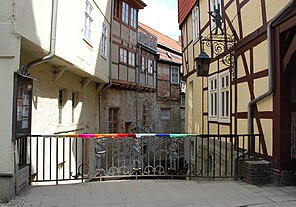Stone Bridge (Quedlinburg)
Coordinates: 51 ° 47 ′ 18 ″ N , 11 ° 8 ′ 30 ″ E
| Stone bridge | ||
|---|---|---|
| View of the course of the stone bridge from the north. The course of the bridge begins around the house with a round bay window in the center of the picture and then extends 103 meters below the street towards the background of the picture. | ||
| Convicted | Mill moat | |
| Subjugated | Road stone bridge | |
| place | Quedlinburg | |
| construction | Stone arch bridge | |
| overall length | 103 m | |
| width | 7.22 m | |
| Number of openings | 23 | |
| Longest span | approx. 4 m | |
| Status | Barely visible to the public, as it is largely below today's street level and most of the bridge arches have been converted into cellars in the course of the overbuilding | |
| closure | from the 13th century only two arches were used as a bridge | |
| location | ||
|
|
||
| Longitudinal section | ||
The stone bridge is a listed bridge over the Mühlgraben in Quedlinburg in Saxony-Anhalt . It is a medieval testimony to the history of transport of national importance. However, since it is below today's ground level, it is difficult to see on site and was forgotten for a long time.
location
The bridge registered in the Quedlinburg register of monuments is located south of the town's market. The stone bridge road, built on both sides, runs over it.
Architecture and history
The existence of a bridge is documented for the first time in 1229. It was used to bridge a swampy area south of the market. The urban areas of Word and Pölle were undeveloped. Today's bridge consists of 23 stone round arches and stretches over 103 meters. Sometimes the number of arcs is only given as 20. However, the apex of the bridge arches are 1.80 meters below the pavement of today's Steinbrücke road. The width of the bridge is 7.22 meters. The individual arches have a span of about four meters, the arch radius is 2.70 meters. Hard limestone was used as building material . The thickness of the vault is 0.50 meters. The arches rest on pillars 1.57 meters wide, but only 0.35 meters high. Even when it was built, the bridge did not cross a deep river, but rather a wide swampy area.
As early as the 13th century, the areas to the west and east of the bridge were drained in order to gain new building land. Buildable areas were created on both long sides of the bridge. The houses built in this way over time used the rooms below the bridge arches as part of their cellars. Today, 21 of the arches are used as a cellar.
In the northern part of the stone bridge, in the area of two arches, the original bridge function still exists today, as the stone bridge leads over the Mühlgraben at this point. In this section of the bridge, the street is delimited by parapet grilles from around 1900, which are decorated with a representation of the Munzenberg musicians.
Over the centuries the bridge was forgotten as a building. During construction work to relocate the city water pipeline in 1880, the bridge was struck again.
At the house Steinbrücke 1, 2 there is a board informing about the stone bridge.
literature
- Adolf Brinkmann : Descriptive representation of the older architectural and art monuments of the district City of Quedlinburg, Volume 2, Berlin 1923, p. 159 f.
- Falko Grubitzsch in: Georg Dehio: Handbook of German Art Monuments . Saxony-Anhalt. Volume 1: Ute Bednarz, Folkhard Cremer and others: Magdeburg administrative region . Revision. Deutscher Kunstverlag , Munich et al. 2002, ISBN 3-422-03069-7 , p. 761
- Wolfgang Hoffmann: Quedlinburg. A guide to the world heritage city . 13th edition. Schmidt-Buch-Verlag, Wernigerode 2010, ISBN 978-3-928977-19-7 , p. 32
- Hans-Hartmut Schauer: The urban monument Quedlinburg and its half-timbered buildings , Verlag für Bauwesen Berlin 1990, ISBN 3-345-00233-7 , p. 28
- State Office for the Preservation of Monuments of Saxony-Anhalt (Ed.): List of monuments in Saxony-Anhalt. Volume 7: Falko Grubitzsch, with the participation of Alois Bursy, Mathias Köhler, Winfried Korf, Sabine Oszmer, Peter Seyfried and Mario Titze: Quedlinburg district. Volume 1: City of Quedlinburg. Fly head, Halle 1998, ISBN 3-910147-67-4 , p. 244
Web links
Individual evidence
- ↑ Falko Grubitzsch in: Georg Dehio: Handbook of German Art Monuments. Saxony-Anhalt. Volume 1: Ute Bednarz, Folkhard Cremer and others: Magdeburg administrative region . Revision. Deutscher Kunstverlag, Munich et al. 2002, ISBN 3-422-03069-7 , p. 761
- ↑ State Office for the Preservation of Monuments in Saxony-Anhalt (ed.): List of monuments in Saxony-Anhalt. Volume 7: Falko Grubitzsch, with the participation of Alois Bursy, Mathias Köhler, Winfried Korf, Sabine Oszmer, Peter Seyfried and Mario Titze: Quedlinburg district. Volume 1: City of Quedlinburg. Fly head, Halle 1998, ISBN 3-910147-67-4 , p. 244
- ↑ a b Hans-Hartmut Schauer: The urban monument Quedlinburg and its half-timbered buildings . Verlag für Bauwesen Berlin 1990, ISBN 3-345-00233-7 , p. 28
- ↑ a b Wolfgang Hoffmann: Quedlinburg. A guide to the world heritage city . 13th edition. Schmidt-Buch-Verlag, Wernigerode 2010, ISBN 978-3-928977-19-7 , p. 32



